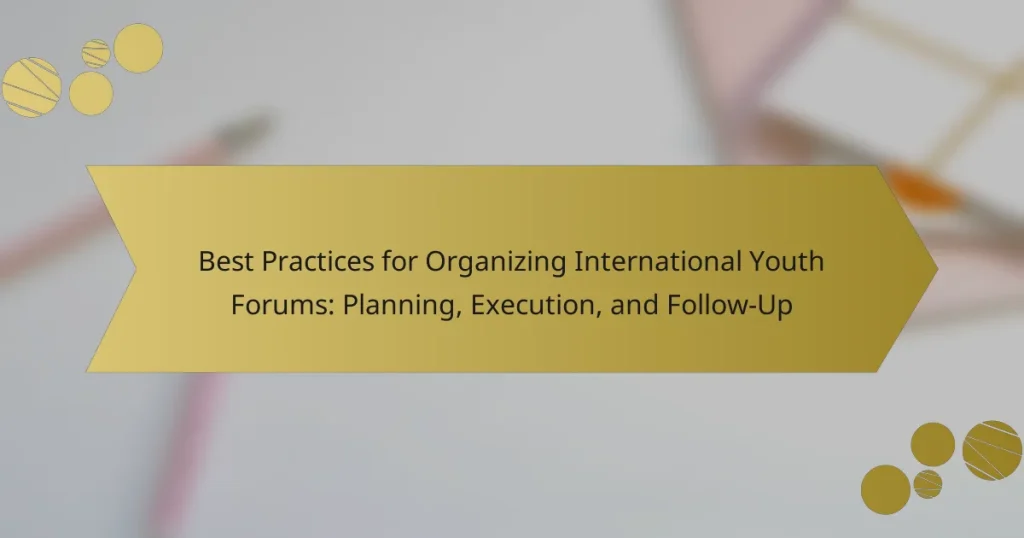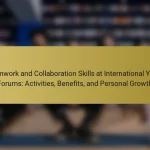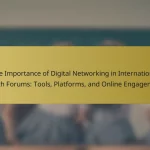The article focuses on best practices for organizing international youth forums, emphasizing key components such as planning, stakeholder engagement, logistics, program development, and evaluation. Effective planning involves establishing clear objectives and timelines, while stakeholder engagement promotes participation from diverse youth groups. Logistics encompass venue selection, accommodation, and transportation, ensuring a smooth event experience. Program development aims to create relevant content that addresses youth issues, and evaluation assesses the forum’s impact for future improvements. The article also highlights the importance of follow-up actions, including feedback collection and outcome sharing, to enhance the sustainability and effectiveness of youth forums.
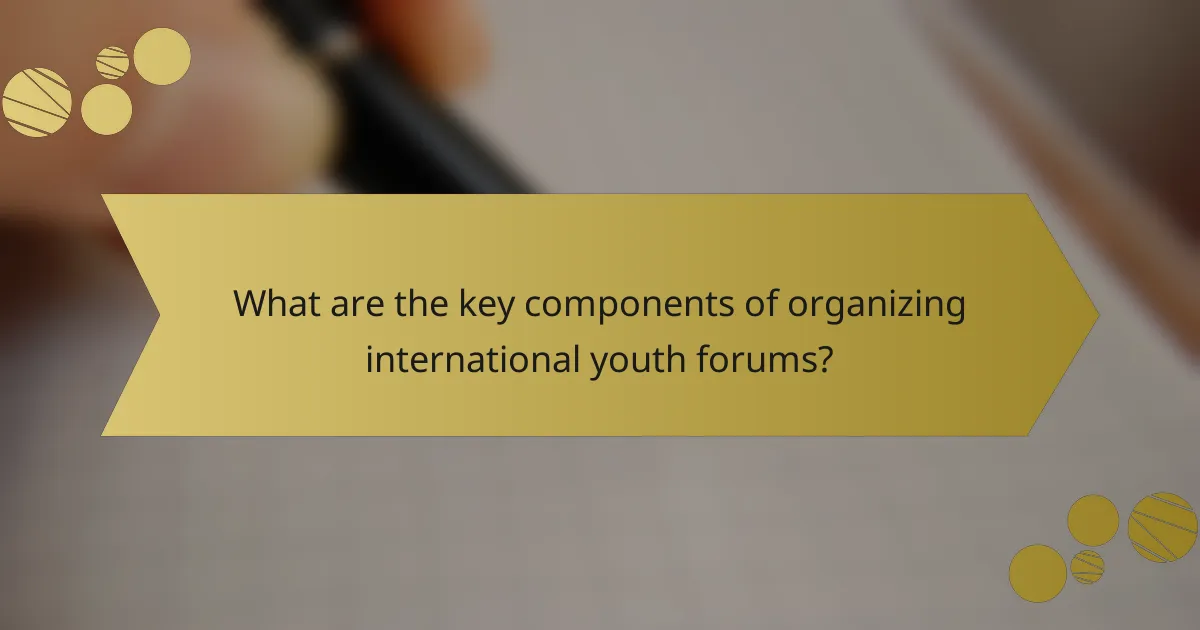
What are the key components of organizing international youth forums?
Key components of organizing international youth forums include planning, stakeholder engagement, logistics, program development, and evaluation. Effective planning involves setting clear objectives and timelines. Stakeholder engagement ensures participation from diverse youth groups and organizations. Logistics cover venue selection, accommodation, and transportation arrangements. Program development focuses on creating relevant content and activities that address youth issues. Evaluation assesses the forum’s impact and gathers feedback for future improvements. Each component is essential for successful execution and sustainability of the forum’s outcomes.
How do you define the objectives of an international youth forum?
The objectives of an international youth forum are defined as promoting dialogue, collaboration, and empowerment among young people. These objectives aim to address global issues affecting youth. They encourage the exchange of ideas and cultural understanding. Forums also aim to develop leadership skills among participants. Additionally, they provide a platform for youth to voice their concerns. The objectives often include fostering partnerships across countries. They focus on creating actionable solutions to shared challenges. These objectives are critical for engaging youth in decision-making processes.
What factors should be considered when setting objectives?
When setting objectives, clarity and specificity are crucial. Objectives should be clear to ensure all participants understand their purpose. Specific objectives help in measuring success effectively. Measurable criteria allow for tracking progress and evaluating outcomes. Achievable goals ensure that objectives are realistic given available resources and time. Relevant objectives align with the broader goals of the international youth forum. Time-bound objectives set deadlines for completion, enhancing accountability. These factors collectively ensure that objectives are well-defined and actionable, leading to successful event outcomes.
How do objectives influence the overall planning process?
Objectives serve as the foundation for the overall planning process. They guide decision-making and resource allocation. Clear objectives help define the scope of the project. They ensure that all team members are aligned with the same goals. When objectives are specific, measurable, achievable, relevant, and time-bound, they enhance focus. This focus leads to more efficient use of time and resources. Research indicates that organizations with clear objectives are 30% more effective in achieving their goals. Therefore, well-defined objectives are crucial for successful planning.
What roles and responsibilities are involved in the planning phase?
The planning phase involves several key roles and responsibilities. Project managers oversee the entire planning process. They ensure that objectives align with the forum’s mission. Coordinators handle logistics, such as venue selection and scheduling. They manage resources and timelines effectively. Content developers create the agenda and materials for discussions. They ensure relevance to the youth audience. Financial officers manage budgets and funding sources. They track expenses and ensure financial sustainability. Stakeholder engagement specialists communicate with participants and partners. They gather input to shape the forum’s direction. Each role is essential for a successful planning phase.
Who should be part of the organizing committee?
The organizing committee should include diverse stakeholders. Key members are youth representatives, educators, and community leaders. They bring unique perspectives and skills. Additionally, include logistics coordinators for event planning. Financial officers are essential for budget management. Public relations experts help with outreach and communication. Legal advisors ensure compliance with regulations. This diverse composition enhances the committee’s effectiveness. Research shows that diverse teams improve problem-solving and innovation (Page, S.E., 2007, “The Difference: How the Power of Diversity Creates Better Groups, Firms, Schools, and Societies”).
What skills are essential for committee members?
Essential skills for committee members include effective communication, teamwork, and leadership. Effective communication enables members to convey ideas clearly and listen actively. Teamwork fosters collaboration, ensuring that diverse perspectives are integrated into decision-making. Leadership skills help guide the committee towards achieving its goals. Additionally, problem-solving abilities are crucial for addressing challenges that arise during planning and execution. Time management ensures that tasks are completed efficiently and deadlines are met. Organizational skills help maintain structure and focus within the committee’s activities. These skills collectively enhance the committee’s effectiveness in organizing successful international youth forums.
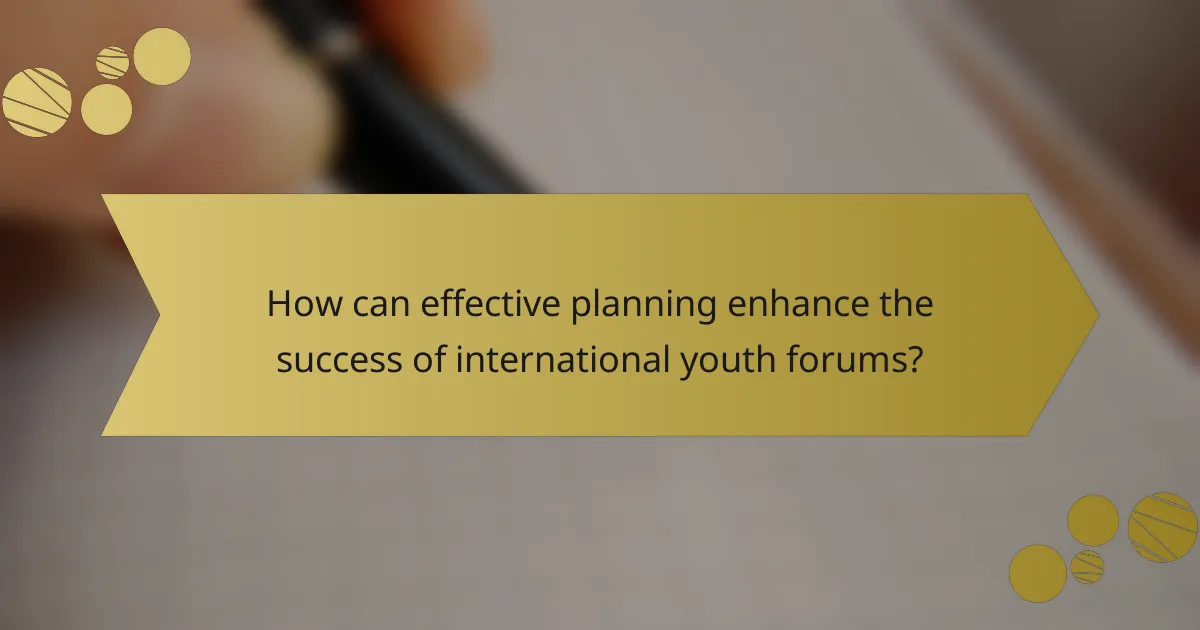
How can effective planning enhance the success of international youth forums?
Effective planning enhances the success of international youth forums by ensuring clear objectives and structured agendas. It allows organizers to identify target participants and relevant topics. This targeted approach increases engagement and relevance for attendees. Effective planning also includes logistical arrangements, such as venue selection and technology setup. Proper logistics minimize disruptions during the event. Furthermore, planning facilitates the allocation of resources, ensuring that all necessary materials are available. A well-planned forum can foster networking opportunities among participants. Research shows that structured events lead to higher satisfaction rates, which is crucial for future forums. According to a study by the International Youth Foundation, well-organized forums significantly boost participant outcomes and engagement levels.
What are the best practices for selecting a venue?
The best practices for selecting a venue include assessing location, capacity, amenities, and accessibility. First, choose a location that is convenient for attendees. This minimizes travel time and enhances participation. Next, ensure the venue can accommodate the expected number of participants comfortably. Overcrowding can lead to a negative experience. Evaluate the amenities offered by the venue. Essential services include audio-visual equipment, Wi-Fi, and catering options. Accessibility is crucial for inclusivity. Verify that the venue complies with accessibility standards for individuals with disabilities. Additionally, consider the venue’s atmosphere and suitability for the event’s theme. A fitting environment can enhance engagement and interaction among participants. Finally, review the venue’s policies on cancellations and flexibility for changes. This protects your investment in case of unforeseen circumstances.
What criteria should be used to evaluate potential venues?
Evaluate potential venues based on location, capacity, facilities, accessibility, and cost. Location should be convenient for attendees, ideally near transportation options. Capacity must accommodate expected participants while allowing for comfort and engagement. Facilities should include necessary technology and amenities, such as Wi-Fi and restrooms. Accessibility is vital for inclusivity, ensuring the venue is usable for individuals with disabilities. Cost must align with the budget, factoring in all associated expenses like rentals and services. These criteria ensure the venue meets the practical needs of the event.
How can accessibility be ensured for all participants?
Accessibility can be ensured for all participants by implementing inclusive practices. This includes providing materials in multiple formats, such as braille and large print. Venues should be wheelchair accessible and equipped with necessary facilities. Clear signage should guide participants throughout the event. Offering sign language interpreters enhances communication for hearing-impaired individuals. Additionally, using assistive technologies can support diverse needs. Gathering feedback from participants about their accessibility needs is crucial. According to the World Health Organization, an estimated 15% of the global population experiences some form of disability, highlighting the importance of these measures.
How should the agenda be structured for maximum engagement?
To maximize engagement, the agenda should include interactive sessions, varied formats, and strategic breaks. Interactive sessions encourage participation and keep attendees focused. Varied formats, such as workshops and discussions, cater to different learning styles. Strategic breaks allow for networking and reflection, enhancing overall engagement. Research shows that agendas incorporating these elements lead to higher participant satisfaction and retention. For example, a study by the Event Marketing Institute found that 78% of attendees prefer events with interactive components.
What types of sessions should be included in the agenda?
The agenda for international youth forums should include keynote sessions, workshops, panel discussions, and networking opportunities. Keynote sessions provide inspirational talks from influential speakers. Workshops allow participants to engage in hands-on activities and skill development. Panel discussions foster dialogue on relevant topics with expert insights. Networking opportunities enable participants to connect and collaborate. Each session type contributes to a well-rounded experience. This structure promotes learning, engagement, and relationship-building among youth attendees.
How can interactive elements be incorporated into the agenda?
Interactive elements can be incorporated into the agenda by including activities that engage participants. Examples include workshops, Q&A sessions, and group discussions. These formats encourage active participation and enhance learning. Polls and surveys can also be integrated to gather real-time feedback. Incorporating technology, such as live polling apps, can further boost interaction. Breakout sessions allow smaller groups to collaborate on specific topics. Icebreaker activities at the start can foster connections among participants. These methods create a dynamic and inclusive environment, making the forum more effective.
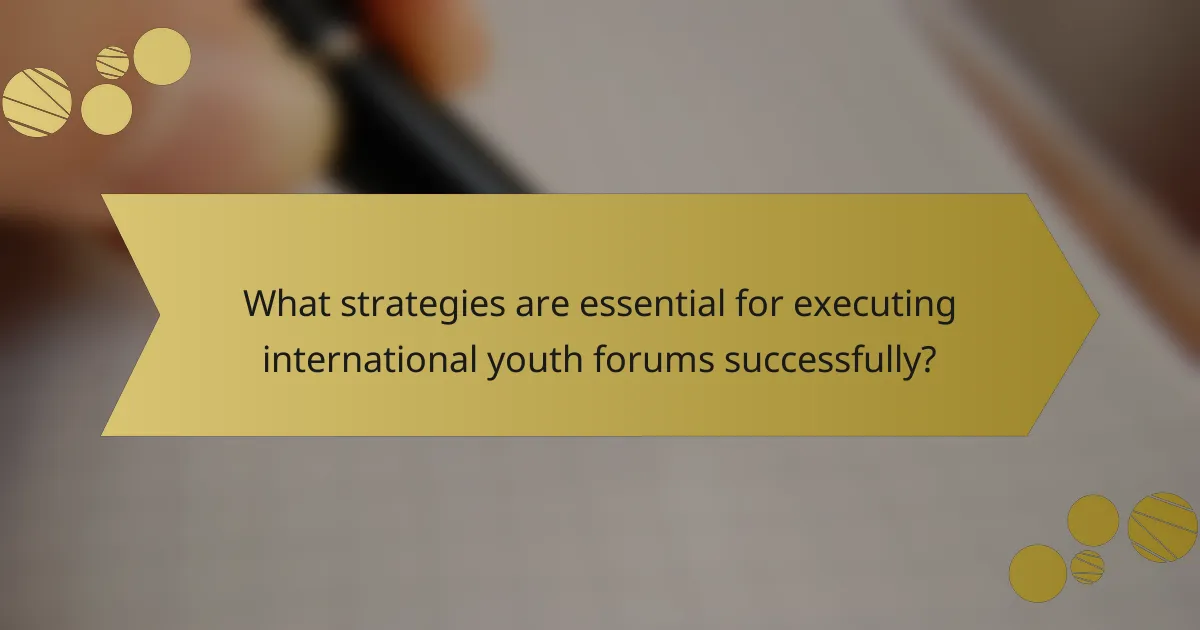
What strategies are essential for executing international youth forums successfully?
Effective strategies for executing international youth forums include comprehensive planning, stakeholder engagement, and cultural sensitivity. Comprehensive planning involves setting clear objectives and timelines. This ensures all participants understand the forum’s purpose. Stakeholder engagement is crucial for fostering collaboration. Involving youth organizations, governments, and sponsors enhances resource availability. Cultural sensitivity promotes inclusivity. Recognizing diverse backgrounds fosters a welcoming environment.
Logistical arrangements must be meticulously organized. This includes venue selection, technology setup, and accommodation. Clear communication channels facilitate information sharing. Utilizing social media can increase outreach and engagement. Feedback mechanisms post-forum help assess success and areas for improvement. These strategies collectively contribute to the successful execution of international youth forums.
How can effective communication be maintained during the event?
Effective communication can be maintained during the event by establishing clear channels for information exchange. Designate specific roles for team members to manage communication. Use technology tools like messaging apps for real-time updates. Schedule regular check-ins to assess communication flow. Provide participants with a communication guide outlining key contacts and protocols. Encourage feedback to identify any communication barriers. Ensure that all information is concise and accessible to all attendees. These strategies enhance clarity and reduce misunderstandings during the event.
What tools can facilitate real-time communication among organizers?
Messaging applications like Slack and Microsoft Teams facilitate real-time communication among organizers. These tools allow for instant messaging, file sharing, and video conferencing. Slack offers channels for topic-specific discussions. Microsoft Teams integrates with other Microsoft Office tools for seamless collaboration. Video conferencing tools such as Zoom also support real-time communication. They enable organizers to hold virtual meetings and share screens. Moreover, Google Meet provides a platform for video calls with collaborative features. These tools collectively enhance coordination and streamline communication among event organizers.
How can participants be encouraged to engage with each other?
Participants can be encouraged to engage with each other by creating structured opportunities for interaction. Icebreaker activities at the beginning of the forum can help participants introduce themselves. Small group discussions can foster deeper connections among attendees. Interactive workshops allow participants to collaborate on shared interests. Utilizing technology, such as event apps, can facilitate networking and communication. Setting clear expectations for participation can motivate attendees to engage actively. Providing incentives for involvement, like recognition or prizes, can also enhance engagement. Research shows that active participation improves overall satisfaction in group settings.
What logistical considerations must be addressed on the event day?
Logistical considerations on the event day include venue setup, registration processes, and technical support. Venue setup must be completed before attendees arrive to ensure a smooth experience. Registration processes should be efficient to minimize wait times. Technical support must be on hand to address any issues with audio-visual equipment. Additionally, transportation arrangements for speakers and participants need to be confirmed. Catering services should be ready to provide meals and refreshments as scheduled. Security measures must be in place to ensure the safety of all attendees. Finally, a clear communication plan should be established to relay information to participants throughout the day.
How can registration processes be streamlined?
Registration processes can be streamlined by implementing online platforms for data collection. These platforms reduce manual entry and errors. Automated confirmation emails enhance communication efficiency. Simplifying forms minimizes user frustration and abandonment rates. Utilizing single sign-on options speeds up user access. Offering mobile-friendly registration caters to a wider audience. Analyzing registration data can identify bottlenecks for future improvements. According to a study by Eventbrite, online registration can increase participation rates by up to 30%.
What measures should be taken to ensure technical support is available?
To ensure technical support is available, organizations should establish a dedicated technical support team. This team must be trained in the relevant technologies and tools used during the forum. A clear communication channel should be set up for participants to report issues. This could include a helpdesk or a dedicated chat service. Regular testing of all technical systems is essential before the event. Backup systems should also be in place to handle potential failures. Documentation and user guides should be provided to assist users. Lastly, a post-event review should be conducted to improve future technical support measures.
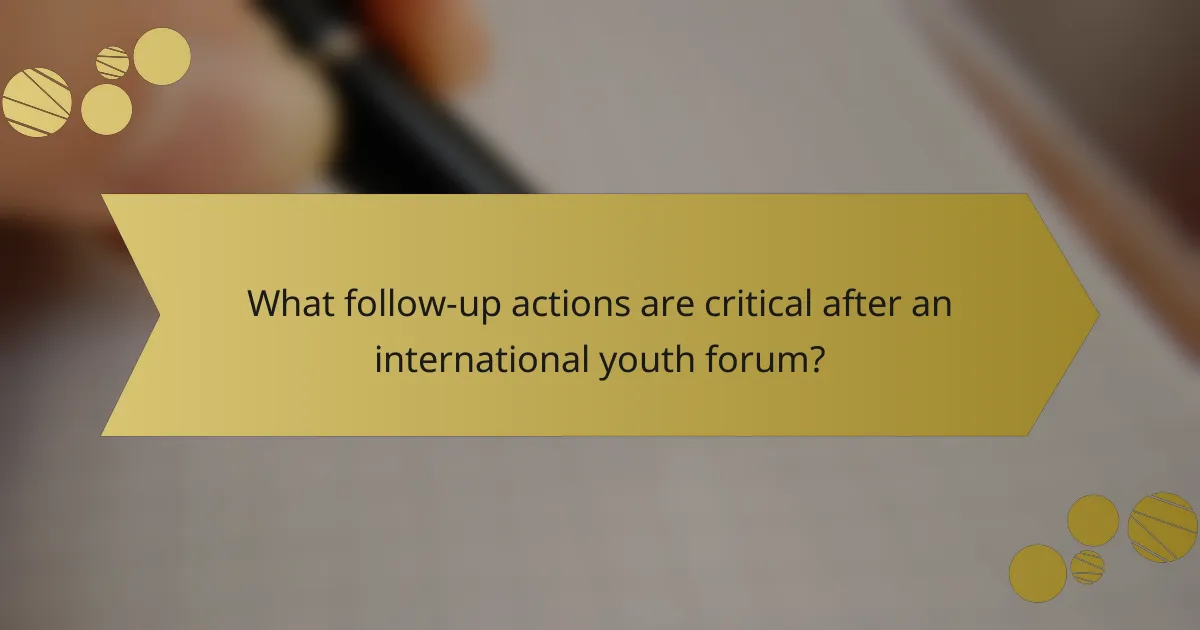
What follow-up actions are critical after an international youth forum?
Critical follow-up actions after an international youth forum include collecting feedback and sharing outcomes. Gathering participant feedback helps assess the forum’s effectiveness. This can be done through surveys or focus groups. Sharing outcomes ensures transparency and accountability. Distributing a summary report to all stakeholders is essential. It should include key discussions and decisions made during the forum. Engaging participants in ongoing discussions fosters community building. Establishing a platform for continuous dialogue is beneficial. Lastly, creating an action plan based on forum insights guides future initiatives. This structured approach enhances the impact of the forum’s outcomes.
How can feedback be effectively collected from participants?
Feedback can be effectively collected from participants through structured surveys and interviews. Surveys should be designed with clear, concise questions to gather specific insights. Online tools like Google Forms or SurveyMonkey can facilitate easy distribution and collection. Interviews can provide deeper qualitative data, allowing for open-ended responses. Timing is crucial; collecting feedback immediately after an event ensures relevance. Additionally, incentivizing participation can increase response rates. Anonymity in responses often encourages honesty. According to a study by the American Psychological Association, structured feedback mechanisms improve response quality and engagement.
What methods can be used to analyze feedback data?
Quantitative analysis and qualitative analysis are methods used to analyze feedback data. Quantitative analysis involves statistical techniques to interpret numerical data. This method can include surveys with rating scales or multiple-choice questions. It allows for the identification of trends and patterns in responses. Qualitative analysis focuses on open-ended feedback and thematic content. This method helps to understand participants’ feelings and perceptions. Techniques such as coding and thematic analysis are commonly used. Combining both methods enhances the overall understanding of the feedback data. This approach provides a comprehensive view of participant experiences.
How can feedback inform future forums?
Feedback can inform future forums by identifying strengths and weaknesses. It provides insights into participant satisfaction. Analyzing feedback helps organizers understand what worked well. This can guide improvements in content and structure. Specific suggestions can enhance engagement strategies. Quantitative data from surveys can highlight trends in preferences. Qualitative comments can reveal deeper insights into participant experiences. Incorporating this information leads to more effective future forums.
What are the best practices for maintaining connections post-forum?
Engaging in follow-up communication is essential for maintaining connections post-forum. Participants should receive a thank-you email within a week of the event. This email should express gratitude and summarize key takeaways. Creating a dedicated online group for participants fosters ongoing dialogue. Regular updates about future events or initiatives keep the community engaged. Encouraging participants to share their experiences and insights strengthens relationships. Organizing periodic virtual meet-ups can facilitate deeper connections. Offering opportunities for collaboration on projects enhances networking. These practices are supported by research indicating that sustained engagement leads to stronger community ties.
How can social media be leveraged for continued engagement?
Social media can be leveraged for continued engagement by creating interactive content. Interactive content encourages participation and fosters a sense of community. Polls, quizzes, and live Q&A sessions can increase user interaction. Regular updates keep the audience informed and engaged. Sharing user-generated content enhances connection and authenticity. Utilizing hashtags can help create a unified conversation. Analytics tools can track engagement metrics to refine strategies. For example, brands that engage audiences through social media see up to 80% higher engagement rates.
What follow-up communications should be sent to participants?
Follow-up communications to participants should include a thank-you message. This message acknowledges their participation and contributions. It can also summarize key takeaways from the event. Additionally, participants should receive a feedback survey. This survey collects their insights on the forum’s effectiveness. Sharing resources or materials discussed during the forum is also essential. This ensures participants have access to valuable information. Lastly, updates about future events or initiatives should be communicated. This keeps participants engaged and informed about ongoing opportunities.
What common challenges arise during the organization of international youth forums?
Common challenges during the organization of international youth forums include logistical issues, cultural differences, and funding constraints. Logistical issues often arise from coordinating travel, accommodation, and venue arrangements for participants from various countries. Cultural differences can lead to misunderstandings in communication and expectations among diverse youth groups. Funding constraints frequently limit the scope and scale of the forum, impacting the ability to provide resources and support for participants. Additionally, engaging youth effectively and ensuring their voices are heard can be challenging due to varying levels of experience and confidence. These challenges require careful planning and collaboration to address effectively.
How can potential challenges be anticipated and mitigated?
Potential challenges in organizing international youth forums can be anticipated and mitigated through thorough planning and proactive strategies. Identifying potential issues early is crucial. Conducting risk assessments helps in recognizing areas of concern. Engaging stakeholders in discussions can provide diverse perspectives on possible challenges. Developing contingency plans ensures readiness for unexpected situations. Regular communication among team members fosters transparency and quick problem-solving. Training volunteers and staff prepares them for real-time challenges. Monitoring progress throughout the planning process allows for timely adjustments. Utilizing feedback mechanisms post-event helps in addressing any unresolved issues for future forums.
What resources are available for troubleshooting issues that arise?
Resources for troubleshooting issues include online forums, help centers, and user manuals. Online forums provide community support and shared experiences. Help centers offer official guidance and FAQs for common problems. User manuals contain detailed instructions for specific equipment or software. Additionally, troubleshooting guides are available online for various platforms. These resources help identify and resolve issues efficiently. Many organizations also provide dedicated support teams for immediate assistance. These teams can offer personalized solutions based on the specific problem encountered.
The main entity of the article is “international youth forums.” This article provides a comprehensive overview of best practices for organizing these forums, emphasizing critical components such as planning, stakeholder engagement, logistics, program development, and evaluation. It details how to define objectives, structure agendas for engagement, and ensure accessibility, while also addressing roles within the organizing committee and essential skills for members. Additionally, the article discusses strategies for effective execution, including communication, technical support, and post-forum follow-up actions, all aimed at enhancing the impact and sustainability of international youth forums.
